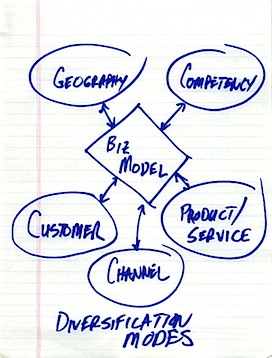One of the trickiest decisions in business is to assess: is this innovation too innovative for my firm? You need to decide, will the core business embrace the new product or service, or reject it? Xerox, which invented the laser printer, ethernet, and the personal computer -- rejected the new computer and network but adopted the laser printer. Why? History is littered with attempts at diversification which "went too far". My friends Chunka Mui and Paul Carroll's book Billion Dollar Lessons, waded into the largely unfathomed waters of large scale business failures, and found a number of firms that tried to diversify into growing markets only to lose money and valuable management time. (in the interests of full disclosure, my firm Diamond Management & Technology Consultants worked with Paul & Chunka on the research in the book.) One of their more memorable stories concerned the attempt by American Standard, famous for their toilets, and a manufacturer of plumbing supplies, air-conditioning and automotive systems to enter the small medical device testing business powered by their core competency in laser technology. As Paul & Chunka point out, even though American Standard was solidly profitable at this time they wanted to grow faster and success in the medical device domain would give them patent protection for their inventions, if successful. In 1997, American Standard bought a series of companies and applied their expertise into the medical device market. By 1999, after $30 million in losses, they took a $126 million write off and sold the division.
In hindsight, it is easy to say they were wrong. But as executives we have to make forward looking not backward looking decisions! If the executives at American Standard were following the logic of "Core Competencies of the Corporation," the very popular 1990 article by Prahalad and Hamel, one could argue that American Standard was making the right bet. So where did they go wrong? How could they have known that their investment was not "close enough" but rather it was "too far out?"
I think we can define "closer" in a very straight forward way. First, if an innovation threatens the core business model -- it is a non-starter. There is no way that the New York Times could have invented Craig's list -- because it would have been commercial suicide. Once we get past that first and vital observation, I believe that we can look for "closeness" by using the some insight from the brilliant business historian Al Chandler. In his 1977 book The Visible Hand, Chandler pointed out that there are five ways to diversify a business: by customer, by distribution channel, by product/service, by geography and by competency. I believe that if the innovation your firm is considering is "close" to current practice on all five of these it is less risky to implement. If it is different on these five dimensions, it becomes much riskier. See the illustration below.

Thinking back to American Standard, the move into medical devices did not threaten the core business model, and it did match closely on competencies, and maybe on geography. However, it was far apart on customer, distribution channel & product/service. Therefore, my little model would say that the diversification was very risky.
Looking forward, I think this model helps explain why I think Microsoft will lose to Google in the war for the mobile phone. First, I believe that third party software for the phone will be advertising supported, not supported by people paying for software applications. According to my friend Andy Lippman co-founder of the MIT Media lab "No one is making money on iPhone applications. They are making money on what other business the iPhone applications is driving for them." I believe Andy knows this is a bit of an exaggeration, but in the main he is right -- the iPhone application revenue stream is not big. Companies should think of iPhone apps just as they think of couponing -- as a way to drive demand. Second, it is impossible for Microsoft to switch over to an advertising driven business model (yes, I know MSN has advertising, but its profits are dwarfed by the software business). They cannot start to give away the razor blades -- it's just too painful.
Google, on the other hand not only has business model compatibility because they are already advertising driven, but they also have competency, customer, geography and product compatibility. They have been developing the distribution capability -- both within the phone companies, and on their own directly. I know there have been complaints about their execution on the service end, and I'm sure the technology will have issues, etc., etc., but I believe that because of the fundamental "closeness" of this innovation, Google will make it work.
So, when considering a new innovation and you are trying to figure out if it will "work" within your firm ask yourself the following questions:
- Does it conflict with our fundamental business model? If yes, STOP!
- If the answer to question 1 is no, then ask yourself how does it fit along the five dimensions in my model. If it misses on a couple, it is risky. If it misses on most, your best bet may be to set up a separate division or company to pursue it.
- Is your career tied up in a move like the one at American Standard?